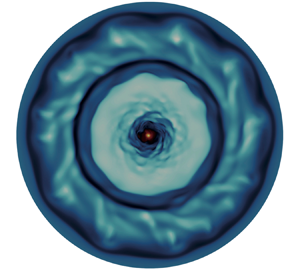Crossref Citations
This article has been cited by the following publications. This list is generated based on data provided by
Crossref.
Davidson, P. A.
Wong, O.
Atkinson, J. W.
and
Ranjan, A.
2022.
Magnetically driven flow in a liquid-metal battery.
Physical Review Fluids,
Vol. 7,
Issue. 7,
Frick, Peter
Mandrykin, Sergei
Eltishchev, Vladislav
and
Kolesnichenko, Ilya
2022.
Electro-vortex flows in a cylindrical cell under axial magnetic field.
Journal of Fluid Mechanics,
Vol. 949,
Issue. ,
Kharicha, Abdellah
Al-Nasser, Mohamad
Barati, Hadi
Karimi-Sibaki, Ebrahim
Vakhrushev, Alexander
Abdi, Mehran
Ludwig, Andreas
and
Wu, Menghuai
2022.
Tornados and cyclones driven by Magneto-hydrodynamic forces.
European Journal of Mechanics - B/Fluids,
Vol. 94,
Issue. ,
p.
90.
Kolesnichenko, Ilya
and
Mandrykin, Sergei
2022.
Spin-up of electro-vortex flows under external magnetic field.
The European Physical Journal Plus,
Vol. 137,
Issue. 8,
Personnettaz, Paolo
Klopper, Tanja Sophia
Weber, Norbert
and
Weier, Tom
2022.
Layer coupling between solutal and thermal convection in liquid metal batteries.
International Journal of Heat and Mass Transfer,
Vol. 188,
Issue. ,
p.
122555.
Acosta-Zamora, K.P.
and
Beltrán, A.
2022.
Study of electromagnetically driven flows of electrolytes in a cylindrical vessel: Effect of electrical conductivity, magnetic field, and electric current.
International Journal of Heat and Mass Transfer,
Vol. 191,
Issue. ,
p.
122854.
Bénard, S.
Herreman, W.
Guermond, J.L.
and
Nore, C.
2022.
Numerical simulations of swirling electrovortex flows in cylinders.
Journal of Fluid Mechanics,
Vol. 950,
Issue. ,
Chen, Zhao-Qi
Wang, Zeng-Hui
Chen, Long
and
Ahmed, Mahmoud
2023.
Heat Transfer Enhancement of Liquid Metal Thermal Convection Affected by the Seebeck Effect and Magnetic Field.
International Journal of Energy Research,
Vol. 2023,
Issue. ,
p.
1.
Duczek, Carolina
Weber, Norbert
Godinez-Brizuela, Omar E.
and
Weier, Tom
2023.
Simulation of potential and species distribution in a Li||Bi liquid metal battery using coupled meshes.
Electrochimica Acta,
Vol. 437,
Issue. ,
p.
141413.
Lee, Juhan
Monrrabal, Gleidys
Sarma, Martins
Lappan, Tobias
Hofstetter, Yvonne Jasmin
Trtik, Pavel
Landgraf, Steffen
Ding, Wenjin
Kumar, Sumit
Vaynzof, Yana
Weber, Norbert
and
Weier, Tom
2023.
Membrane‐Free Alkali Metal‐Iodide Battery with a Molten Salt.
Energy Technology,
Vol. 11,
Issue. 7,
Zhou, Xianbo
Gao, Chenglian
Wang, Kangli
Jiang, Kai
and
Li, Haomiao
2024.
A Comparative Study of Thermally and Electromagnetically Driven Flow in the Electrolyte of Liquid Metal Batteries and Their Effects on Ion Transport.
IEEE Transactions on Industry Applications,
Vol. 60,
Issue. 1,
p.
1760.
Duczek, C.
Horstmann, G. M.
Ding, W.
Einarsrud, K. E.
Gelfgat, A. Y.
Godinez-Brizuela, O. E.
Kjos, O. S.
Landgraf, S.
Lappan, T.
Monrrabal, G.
Nash, W.
Personnettaz, P.
Sarma, M.
Sommerseth, C.
Trtik, P.
Weber, N.
and
Weier, T.
2024.
Fluid mechanics of Na-Zn liquid metal batteries.
Applied Physics Reviews,
Vol. 11,
Issue. 4,
Kumar, Dhananjay
and
Mondal, Pranab Kumar
2024.
Mixing of inelastic non-Newtonian fluids with inlet swirl.
Journal of Fluid Mechanics,
Vol. 997,
Issue. ,
Zhou, Xianbo
Fan, Lei
Yan, Shuai
Zhang, Weixin
Li, Bo
Li, Haomiao
Wang, Kangli
and
Jiang, Kai
2024.
Enhancing capacity utilization of Li|LiCl-KCl-CsCl|Bi (300 °C) liquid metal batteries through the application of external magnetic fields.
Journal of Power Sources,
Vol. 624,
Issue. ,
p.
235516.
Ranawade, Vishal
Verma, Rahul
Tiwari, Naveen
and
Nalwa, Kanwar Singh
2024.
A comprehensive multiphysics approach to model solutal buoyancy, thermal convection, and electro-vortex flow phenomena for liquid metal batteries.
Journal of Energy Storage,
Vol. 85,
Issue. ,
p.
111100.
Soni, Swapnil
Ranjan, Avishek
and
Gohil, Trushar B.
2024.
Evaluating approaches to accurately compute electro-vortex flows in liquid metal electrodes.
Computers & Fluids,
Vol. 273,
Issue. ,
p.
106205.
Ranawade, Vishal
Tiwari, Naveen
and
Nalwa, Kanwar Singh
2025.
External magnetic field and heating reduce the mass transport overpotential in a liquid metal battery.
Journal of Energy Storage,
Vol. 131,
Issue. ,
p.
115890.
Cappanera, Loic
and
Giordano, Salvatore
2025.
Artificial Compressibility Method for the Incompressible Navier–Stokes Equations With Variable Density.
Numerical Methods for Partial Differential Equations,
Vol. 41,
Issue. 5,
Keogh, Declan Finn
Baldry, Mark
Timchenko, Victoria
Reizes, John
and
Menictas, Chris
2025.
Realising large areal capacities in liquid metal batteries: A battery design concept for mass transfer enhancement.
Applied Energy,
Vol. 377,
Issue. ,
p.
124345.
Abdelshafy, Mohammad Y.
Wang, Bitong
Mohammad, Ibrahim
Cheng, Jonathan S.
and
Kelley, Douglas H.
2025.
Current-driven flow transitions in laboratory liquid metal battery models.
Journal of Fluid Mechanics,
Vol. 1007,
Issue. ,



